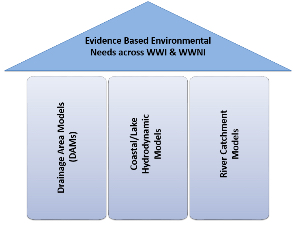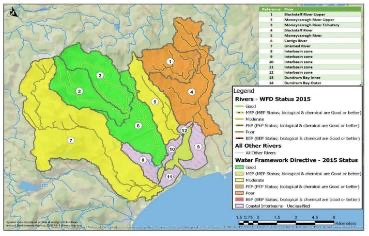Situation
 For sustainable and cost proportionate wastewater capital solutions, the catchment
context in terms of environmental performance outcomes in the receiving environment
must be considered. With increasingly stringent environmental discharge consenting and
challenging Environmental Legislative targets across Northern Ireland it is essential that
investment is efficient and delivers the desired outcome for society. This requires a more
holistic approach by NI Water, its environmental regulator (NIEA), land managers and
catchment stakeholders.
For sustainable and cost proportionate wastewater capital solutions, the catchment
context in terms of environmental performance outcomes in the receiving environment
must be considered. With increasingly stringent environmental discharge consenting and
challenging Environmental Legislative targets across Northern Ireland it is essential that
investment is efficient and delivers the desired outcome for society. This requires a more
holistic approach by NI Water, its environmental regulator (NIEA), land managers and
catchment stakeholders.
Integrated Environmental Modelling (IEM) provides the key evidence in the asset appraisal process because the impact of all NI Water wastewater asset discharges are simulated at a catchment scale that includes diffuse pollutant sources.
The IEM framework is an integration of core NI Water modelling work streams (river catchment models, hydrodynamic (coastal/lake) models and drainage area plan (DAP) sewerage network models) for informing discharge impact assessments across our wastewater asset base and networks.
In November 2019, the NIEA Board adopted a Catchment Based approach to its discharge consenting policy for point sources. There was also agreement in principle to the IEM method being progressed by NI Water. The application of the modelling framework & strategy provides evidence for informing catchment scale solutions to catchment scale problems through stakeholder participation and agreement.
Action
NI Water’s foundation IEM project focussed on Dundrum Bay.
 Four major freshwater sources were modelled for nutrients and bacteria. Assessments
were undertaken within the rivers and coastal environment to understand:
Four major freshwater sources were modelled for nutrients and bacteria. Assessments
were undertaken within the rivers and coastal environment to understand:
- their classifications status
- the pollutant sources that may be driving the classification and
- the work needed to improve overall water quality using acollaborative approach via the cross-agency Dundrum Priority Catchment Group, chaired by DAERA.
The main findings were that NI Water infrastructure was the main source of bacterial pollution in the Inner South Shellfish Water Protected Area (SWPA) but had less of an impact in the Inner North SWPA.
In terms of nutrient enrichment, it demonstrated that NI Water was not as significant a contributor as other sources of nutrient pollution.
These findings highlighted that investment in NI Water assets alone would not achieve the desired outcome of remediating the water quality of Dundrum Bay. Reductions in farmland run-off to waterways would also be required to attain the Bay’s nutrient and bacterial water quality targets i.e. a catchment-based approach incorporating NI Water asset improvements and pollutant reduction measures are needed to deliver the lowest cost-effective solution for stakeholders.

Results
As IPAC has been used to cost up all PC21 Capital Projects it has the additional advantage of allowing benchmarking to be carried out, as evidenced in the recent Batch 1 of Regulatory Scope Certainty projects. The individual elements of each project which were submitted within the Business Plan were directly compared to the most up to date project data, highlighting changes and increases in the scope, as well as the resultant change in costs. This tool was described by the NI Water Board Assurance Team as ‘as good as they have seen in the industry.’ Going forward, IPAC is to be used for pricing up all Capital Works Projects, delivering a Baseline Target Cost to which efficiency challenges would be applied and may be further developed to better meet the changing needs of NI Water.